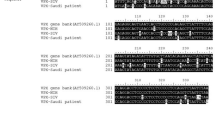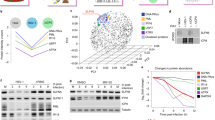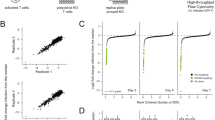Abstract
Human immunodeficiency virus (HIV) actively modulates the protein stability of host cells to optimize viral replication. To systematically examine this modulation in HIV infection, we used isobaric tag-based mass spectrometry to quantify changes in the abundance of over 14,000 proteins during HIV-1 infection of human primary CD4+ T cells. We identified P-selectin glycoprotein ligand 1 (PSGL-1) as an HIV-1 restriction factor downregulated by HIV-1 Vpu, which binds to PSGL-1 and induces its ubiquitination and degradation through the ubiquitin ligase SCFβ-TrCP2. PSGL-1 is induced by interferon-γ in activated CD4+ T cells to inhibit HIV-1 reverse transcription and potently block viral infectivity by incorporating in progeny virions. This infectivity block is antagonized by Vpu via PSGL-1 degradation. We further show that PSGL-1 knockdown can significantly abolish the anti-HIV activity of interferon-γ in primary CD4+ T cells. Our study identifies an HIV restriction factor and a key mediator of interferon-γ’s anti-HIV activity.
This is a preview of subscription content, access via your institution
Access options
Access Nature and 54 other Nature Portfolio journals
Get Nature+, our best-value online-access subscription
$29.99 / 30 days
cancel any time
Subscribe to this journal
Receive 12 digital issues and online access to articles
$119.00 per year
only $9.92 per issue
Buy this article
- Purchase on Springer Link
- Instant access to full article PDF
Prices may be subject to local taxes which are calculated during checkout






Similar content being viewed by others
Code availability
The computational code used in this study is available from the corresponding authors upon request.
Data availability
The data that support the findings of this study are available from the corresponding authors upon request. The raw proteomic data have been uploaded to the ProteomeXchange data repository with the ID number: PXD011233.
References
Malim, M. H. & Bieniasz, P. D. HIV restriction factors and mechanisms of evasion. Cold Spring Harb. Perspect. Med. 2, a006940 (2012).
Yan, N. & Chen, Z. J. Intrinsic antiviral immunity. Nat. Immunol. 13, 214–222 (2012).
Towers, G. J. & Noursadeghi, M. Interactions between HIV-1 and the cell-autonomous innate immune system. Cell Host Microbe 16, 10–18 (2014).
Altfeld, M. & Gale, M. Jr. Innate immunity against HIV-1 infection. Nat. Immunol. 16, 554–562 (2015).
Simon, V., Bloch, N. & Landau, N. R. Intrinsic host restrictions to HIV-1 and mechanisms of viral escape. Nat. Immunol. 16, 546–553 (2015).
Harris, R. S., Hultquist, J. F. & Evans, D. T. The restriction factors of human immunodeficiency virus. J. Biol. Chem. 287, 40875–40883 (2012).
Daugherty, M. D. & Malik, H. S. Rules of engagement: molecular insights from host–virus arms races. Annu. Rev. Genet. 46, 677–700 (2012).
Stremlau, M. et al. The cytoplasmic body component TRIM5α restricts HIV-1 infection in Old World monkeys. Nature 427, 848–853 (2004).
Sheehy, A. M., Gaddis, N. C., Choi, J. D. & Malim, M. H. Isolation of a human gene that inhibits HIV-1 infection and is suppressed by the viral Vif protein. Nature 418, 646–650 (2002).
Neil, S. J., Zang, T. & Bieniasz, P. D. Tetherin inhibits retrovirus release and is antagonized by HIV-1 Vpu. Nature 451, 425–430 (2008).
Hrecka, K. et al. Vpx relieves inhibition of HIV-1 infection of macrophages mediated by the SAMHD1 protein. Nature 474, 658–661 (2011).
Laguette, N. et al. SAMHD1 is the dendritic- and myeloid-cell-specific HIV-1 restriction factor counteracted by Vpx. Nature 474, 654–657 (2011).
Rosa, A. et al. HIV-1 Nef promotes infection by excluding SERINC5 from virion incorporation. Nature 526, 212–217 (2015).
Usami, Y., Wu, Y. & Gottlinger, H. G. SERINC3 and SERINC5 restrict HIV-1 infectivity and are counteracted by Nef. Nature 526, 218–223 (2015).
Yu, X. et al. Induction of APOBEC3G ubiquitination and degradation by an HIV-1 Vif–Cul5–SCF complex. Science 302, 1056–1060 (2003).
Mitchell, R. S. et al. Vpu antagonizes BST-2-mediated restriction of HIV-1 release via β-TrCP and endo-lysosomal trafficking. PLoS Pathog. 5, e1000450 (2009).
Van Damme, N. et al. The interferon-induced protein BST-2 restricts HIV-1 release and is downregulated from the cell surface by the viral Vpu protein. Cell Host Microbe 3, 245–252 (2008).
Matheson, N. J. et al. Cell surface proteomic map of HIV infection reveals antagonism of amino acid metabolism by Vpu and Nef. Cell Host Microbe 18, 409–423 (2015).
Greenwood, E. J. et al. Temporal proteomic analysis of HIV infection reveals remodelling of the host phosphoproteome by lentiviral Vif variants. eLife 5, e18296 (2016).
Chan, E. Y. et al. Dynamic host energetics and cytoskeletal proteomes in human immunodeficiency virus type 1-infected human primary CD4 cells: analysis by multiplexed label-free mass spectrometry. J. Virol. 83, 9283–9295 (2009).
Wojcechowskyj, J. A. et al. Quantitative phosphoproteomics reveals extensive cellular reprogramming during HIV-1 entry. Cell Host Microbe 13, 613–623 (2013).
Zhou, F. et al. Genome-scale proteome quantification by DEEP SEQ mass spectrometry. Nat. Commun. 4, 2171 (2013).
Sugden, S. M., Bego, M. G., Pham, T. N. & Cohen, E. A. Remodeling of the host cell plasma membrane by HIV-1 Nef and Vpu: a strategy to ensure viral fitness and persistence. Viruses 8, 67 (2016).
van ‘t Wout, A. B. et al. Nef induces multiple genes involved in cholesterol synthesis and uptake in human immunodeficiency virus type 1-infected T cells. J. Virol. 79, 10053–10058 (2005).
Rusinova, I. et al. Interferomev2.0: an updated database of annotated interferon-regulated genes. Nucleic Acids Res. 41, D1040–D1046 (2013).
McLaren, P. J. et al. Identification of potential HIV restriction factors by combining evolutionary genomic signatures with functional analyses. Retrovirology 12, 41 (2015).
Kosiol, C. et al. Patterns of positive selection in six mammalian genomes. PLoS Genet. 4, e1000144 (2008).
Cohen, G. B. et al. The selective downregulation of class I major histocompatibility complex proteins by HIV-1 protects HIV-infected cells from NK cells. Immunity 10, 661–671 (1999).
Zahoor, M. A. et al. HIV-1 Vpr induces interferon-stimulated genes in human monocyte-derived macrophages. PLoS ONE 9, e106418 (2014).
Maitra, R. K. & Silverman, R. H. Regulation of human immunodeficiency virus replication by 2′,5′-oligoadenylate-dependent RNase L. J. Virol. 72, 1146–1152 (1998).
Shah, A. H. et al. Degranulation of natural killer cells following interaction with HIV-1-infected cells is hindered by downmodulation of NTB-A by Vpu. Cell Host Microbe 8, 397–409 (2010).
Grover, J. R., Veatch, S. L. & Ono, A. Basic motifs target PSGL-1, CD43, and CD44 to plasma membrane sites where HIV-1 assembles. J. Virol. 89, 454–467 (2015).
Mangeat, B. et al. HIV-1 Vpu neutralizes the antiviral factor tetherin/BST-2 by binding it and directing its β-TrCP2-dependent degradation. PLoS Pathog. 5, e1000574 (2009).
Margottin, F. et al. A novel human WD protein, h-βTrCp, that interacts with HIV-1 Vpu connects CD4 to the ER degradation pathway through an F-box motif. Mol. Cell 1, 565–574 (1998).
Shirogane, T., Jin, J., Ang, X. L. & Harper, J. W. SCFβ-TrCP controls clock-dependent transcription via casein kinase 1-dependent degradation of the mammalian period-1 (Per1) protein. J. Biol. Chem. 280, 26863–26872 (2005).
Vigan, R. & Neil, S. J. Determinants of tetherin antagonism in the transmembrane domain of the human immunodeficiency virus type 1 Vpu protein. J. Virol. 84, 12958–12970 (2010).
Cavrois, M., De Noronha, C. & Greene, W. C. A sensitive and specific enzyme-based assay detecting HIV-1 virion fusion in primary T lymphocytes. Nat. Biotechnol. 20, 1151–1154 (2002).
Wu, Y., Beddall, M. H. & Marsh, J. W. Rev-dependent indicator T cell line. Curr. HIV Res. 5, 394–402 (2007).
Lam, S. S. et al. Directed evolution of APEX2 for electron microscopy and proximity labeling. Nat. Methods 12, 51–54 (2015).
Lamsoul, I., Uttenweiler-Joseph, S., Moog-Lutz, C. & Lutz, P. G. Cullin 5-RING E3 ubiquitin ligases, new therapeutic targets? Biochimie 122, 339–347 (2016).
Sauter, D. & Kirchhoff, F. Multilayered and versatile inhibition of cellular antiviral factors by HIV and SIV accessory proteins. Cytokine Growth Factor Rev. 40, 3–12 (2018).
Hotter, D. & Kirchhoff, F. Interferons and beyond: induction of antiretroviral restriction factors. J. Leukoc. Biol. 103, 465–477 (2018).
Rihn, S. J. et al. The envelope gene of transmitted HIV-1 resists a late interferon γ-induced block. J. Virol. 91, e02254-16 (2017).
Zhang, Y. et al. A robust error model for iTRAQ quantification reveals divergent signaling between oncogenic FLT3 mutants in acute myeloid leukemia. Mol. Cell. Proteomics 9, 780–790 (2010).
Jiang, C. et al. A non-viral CRISPR/Cas9 delivery system for therapeutically targeting HBV DNA and pcsk9 in vivo. Cell Res. 27, 440–443 (2017).
Roesch, F. et al. Hyperthermia stimulates HIV-1 replication. PLoS Pathog. 8, e1002792 (2012).
Butler, S. L., Hansen, M. S. & Bushman, F. D. A quantitative assay for HIV DNA integration in vivo. Nat. Med. 7, 631–634 (2001).
Martell, J. D., Deerinck, T. J., Lam, S. S., Ellisman, M. H. & Ting, A. Y. Electron microscopy using the genetically encoded APEX2 tag in cultured mammalian cells. Nat. Protoc. 12, 1792–1816 (2017).
Acknowledgements
This work was supported by grants from the State Key Research Development Program of China to X.T. (no. 2016YFC1200303) and F.Z. (no. 2017YFA0505100), the China National Funds for Excellent Young Scientists (no. 31722030), grants from the National Natural Science Foundation of China to X.-F.Y. (no. 81772169) and F.Z. (no. 31670836), a grant from the Shanghai Institute of Higher Learning to F.Z. (no. TP2015003) and a grant from the NIMH, US Public Health Service to Y.W. (no. 5R01MH102144). We thank Q. Wang and X. Ye (Institute of Microbiology of the Chinese Academy of Sciences) for the use of the Biosafety level 3 Tissue Culture Facility. We thank H. Qi, N. Yan, H. Deng, A. Elia and N. Zheng for critical reading of the manuscript.
Author information
Authors and Affiliations
Contributions
X.T. conceived and supervised the project. F.Z. conducted the mass spectrometry experiment and data analysis. Y.L. conducted most of the experiments with help from C.F., H.Z., S.L., T.Z. and X.K. Y.F., Z.Z. and D.D. conducted experiments on PSGL-1-blocking viral infectivity and western blot detection of PSGL-1 in virions. Y.W. supervised experiments on PSGL-1-blocking viral infectivity. J.Su and X.-F.Y. contributed to supervision and data analysis of the project. J.Sun and Y.Z. contributed key reagents and performed clinical analysis of the study. Q.W., J.G., M.L., W.Z. and Z.S. contributed to the data analysis. X.T. and F.Z. wrote and Y.W. edited the manuscript.
Corresponding authors
Ethics declarations
Competing interests
The authors declare no competing interests.
Additional information
Publisher’s note: Springer Nature remains neutral with regard to jurisdictional claims in published maps and institutional affiliations.
Supplementary information
Supplementary Information
Supplementary Figures 1–6, Supplementary Table 1 and legends for Supplementary Datasets.
Supplementary Dataset 1
Raw mass spectrometry intensities of all identified proteins.
Supplementary Dataset 2
List of proteins with differential abundances among cell populations.
Supplementary Dataset 3
Gene ontology analysis of proteins with differential abundances among cell populations.
Supplementary Dataset 4
List of interferon-stimulated genes.
Supplementary Dataset 5
List of read counts of RNA-seq analysis.
Supplementary Dataset 6
List of genes with differential mRNA levels among cell populations.
Supplementary Dataset 7
List of positively selected genes.
Rights and permissions
About this article
Cite this article
Liu, Y., Fu, Y., Wang, Q. et al. Proteomic profiling of HIV-1 infection of human CD4+ T cells identifies PSGL-1 as an HIV restriction factor. Nat Microbiol 4, 813–825 (2019). https://doi.org/10.1038/s41564-019-0372-2
Received:
Accepted:
Published:
Issue Date:
DOI: https://doi.org/10.1038/s41564-019-0372-2
This article is cited by
-
Nanopore DNA sequencing technologies and their applications towards single-molecule proteomics
Nature Chemistry (2024)
-
Core-predominant gut fungus Kazachstania slooffiae promotes intestinal epithelial glycolysis via lysine desuccinylation in pigs
Microbiome (2023)
-
Identification of CD38, CD97, and CD278 on the HIV surface using a novel flow virometry screening assay
Scientific Reports (2023)
-
P-selectin glycoprotein ligand-1 (PSGL-1/CD162) is incorporated into clinical HIV-1 isolates and can mediate virus capture and subsequent transfer to permissive cells
Retrovirology (2022)
-
Rapid, efficient and activation-neutral gene editing of polyclonal primary human resting CD4+ T cells allows complex functional analyses
Nature Methods (2022)



